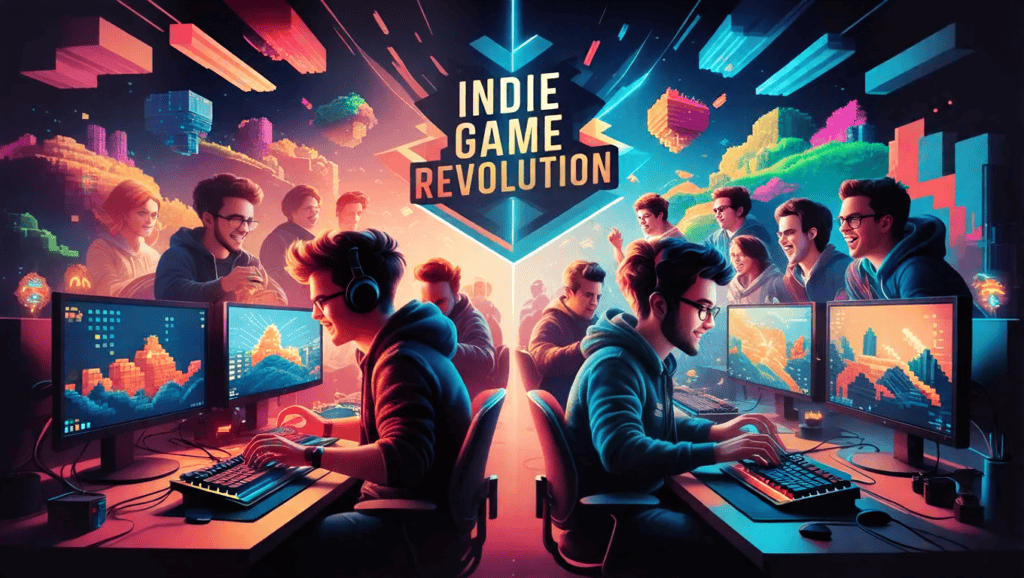Introduction
The world of video games has seen a seismic shift over the past decade, with indie games rising from the shadows to become some of the most celebrated titles in the industry. No longer just a niche, indie games now stand shoulder to shoulder with big-budget blockbusters, offering players unique experiences that often push the boundaries of creativity and innovation.
The Appeal of Indie Games
Indie games have captured the hearts of gamers by embracing what big studios often overlook: originality and artistic freedom. Without the constraints of massive budgets or the need to cater to the widest possible audience, indie developers can take risks and explore new ideas. This freedom has led to the creation of games like Hades, Stardew Valley, and Celeste, which have not only garnered critical acclaim but also cultivated passionate fan bases.
These games often stand out because they offer something different—whether it’s a unique art style, an emotionally resonant story, or innovative gameplay mechanics. Hades, for example, combines fast-paced action with a rich narrative, while Stardew Valley revitalized the farming sim genre with its charming pixel art and deep gameplay systems. These titles prove that you don’t need a blockbuster budget to create a game that resonates with players.

Impact on the Gaming Industry
The success of indie games has had a profound impact on the gaming industry as a whole. Big studios are now taking cues from indie developers, incorporating more innovative design choices and storytelling techniques into their games. The rise of digital distribution platforms like Steam, the Epic Games Store, and even consoles like the Nintendo Switch has also made it easier for indie games to reach a global audience.
Moreover, crowdfunding platforms like Kickstarter have empowered indie developers to bring their visions to life without relying on traditional publishers. This has led to a more diverse gaming landscape, where a wide range of voices and ideas can flourish.
Challenges Faced by Indie Developers
Despite their successes, indie developers often face significant challenges. Limited budgets mean that many indie games are passion projects, built with small teams—or even solo developers—working long hours. Marketing can also be a major hurdle, as indie games must compete with well-funded titles for visibility. The crowded market makes it difficult for new games to stand out, even if they offer a unique experience.
However, the indie community is known for its resilience and resourcefulness. Developers often rely on social media, word-of-mouth, and community engagement to build their audiences. Platforms like YouTube and Twitch have also become vital for indie games, with streamers and content creators helping to spread the word about hidden gems.
The Future of Indie Gaming
As the gaming industry continues to evolve, the role of indie games is likely to grow even more significant. With the increasing accessibility of game development tools and the continued support from digital platforms, indie games are poised to continue their upward trajectory. The industry’s appetite for fresh ideas and diverse voices suggests that indie developers will continue to shape the future of gaming in meaningful ways.
Conclusion
The indie game revolution is far from over. As independent developers continue to push the boundaries of what games can be, they are not only changing the industry but also expanding the very definition of what a video game can achieve. For gamers, this means more innovative, personal, and diverse experiences that reflect the true potential of the medium.
10 August 2024 The Indie Game Revolution: Why Independent Developers are Dominating the Scene
24 November 2023 Shadows of Hyrule: A Dark Fantasy Odyssey through A.I.-Generated Art in The Legend of Zelda
24 November 2023 Stoicism on TikTok: The Unexpected Renaissance of Wisdom for the Modern Man
22 November 2023 Cowboy Bebop: A Galactic Masterpiece vs. Netflix’s Stellar Flop
22 November 2023 The McLegal Fiasco: Jamie Oliver’s Alleged Triumph Over ‘Toxic’ McDonald’s
22 November 2023 Silver Surfer’s Gender Swap: A Cosmic Catastrophe Marvel Fans Will Never Surf Past
16 November 2023 Walt’s Worst Nightmare: Mickey’s Dance Moves Leave Fans Wishing Upon a Different Star!
14 November 2023 A long time ago in a reality far, far away…
13 November 2023 16-Bit Triumphs: The Unforgettable Saga of the Best Super Nintendo Games
13 November 2023 Aurelian Wisdom: Balancing Tolerance and Self-Discipline in a Modern World


